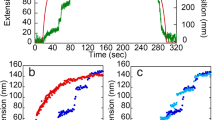Summary
In a companion paper, the shapes of spectrin deficient mouse erythrocytes were described; in contrast to previous assumptions, spherules with tethered microvesicles rather than true “spherocytes” were found. Thence, spectrin deficient mouse erythrocytes are endowed with an excess of surface area for the given volume but the membrane is assuming a highly positive curvature. Observations during and after the action of enzymes cleaving the red cell surface charge (Neuraminidase, Trypsin, Chymotrypsin) showed that the previously positive membrane curvature, as well as the tendency of the membrane to flow into fingerlike protrusions was completely abolished. The erythrocytes of the spectrin deficient, desialylated mouse erythrocytes assumed a variety of shapes, often discocytic or even stomatocytic, i.e. their membrane presented with negative curvature. However, while these desialylated membranes could be easily deformed (elongated) by shear flow they did not recoil elastically into any definitive configuration after removal of the deforming forces. It is concluded from these observations that spectrin (acting on the inner interface between membrane and cytoplasm) and sialic acid residues (acting on the outer interface between membrane and plasma) exert antagonizing effects on membrane curvature and membrane bending elasticity. Sialic acid residues, strongly charged and situated on the outer side of the cell, produce positive membrane curvature; this observation can most readily be explained by assuming that this mechanical effect is caused by repulsive coulombic forces expanding the outer half of the bilayer. To explain the effect of the spectrin-complex in counteracting positive or in producing negative membrane curvature, a similar expansive coulombic force acting between the highly charged residues has been postulated. Thence, a model for explaining the overall elastic behaviour of the normal mammalian red cell is developed which is based on the assumption of elastic interactions of proteinacous membrane components coupled to the lipid bilayer of the membrane.
Similar content being viewed by others
References
Alhanaty E, Sheetz P (1984) Cell membane shape control — effects of chloromethyl ketone peptides. Blood 63: 1203–1208
Coakley WT, Deeley Jot (1980) Effects of ionic strength, serum protein and surface charge on membrane movements and vesicle production in heated erythrocytes. Biochim Biophys Acta 602: 355–375
Delatour E, Hanns M (1984) Transmission grating velocimeter for particles electric mobility measurements. Rev Sci Instruments 55: 508–513
Deuling HJ, Helfrich W (1977) A theoretical explanation for the myelin shapes of red blood cells. Blood Cells 3: 725–726
Evans EA, Skalak R (1979) Mechanics and Thermodynamics of Biomembranes, Part I. Crit Rev Bioeng 3: 181
Fairbanks G, Patel VP, Dino JE (1981) Biochemistry of ATP-dependent red cell membrane shape change. Scand J Clin Lab Invest [Suppl 156] 41: 139–144
Fuhrmann GF (1968) Kationentransport, Hemolyse und Fragmentierung von menschlichen Erythrozyten in Harnstofflösungen. Blut: 321–327
Grebe R, Schmid-Schönbein H (1986) Tangent counting for objective assessment of erythrocyte shape changes. Biorheology (in press)
Greenquist AC, Shohet SB, Bernstein SE (1978) Marked reduction of spectrin in hereditary spherocytosis in the common house mouse. Blood 51: 1149
Jan KM, Chien S (1973) Role of the electrostatic repulsive force in red cell interactions. Bibl Anat 11: 281–288
Lange Y, Cutler HB, Steck TL (1980) The effect of cholesterol and other intercalated amphipaths on the contour and stability of the isolated red cell membrane. J Biol Chem 255: 9331–9337
Lutz HU, Liu SH CH, Palek J (1977) Release of spectrin free vesicles from human erythrocytes during ATP-depletion. J Cell Biol 73: 548–560
Marchesi VT (1979) Functional proteins of the human red cell membrane. Semi Hematol 16: 3–20
McDaniel RV, McLaughlin AM, Winiski AP, Eisenberg M, McLaughlin S (1984) Bilayer membranes containing the ganglioside GM 1: Models for electrostatic potentials adjacent to biological membranes. Biochem 23: 418–462
Parsegian VA (1973) Long range physical forces in the biological milieu. Annu Rev Biophys Bioeng 2: 221
Schmid-Schönbein H, Von Gosen J, Heinich L, Klose HJ, Volger E (1973) A counter rotating “rheoscope chamber” for the study of the microtheology of blood cell aggregation by microscopic observation and microphotometry. Microvasc Res 6: 366–376
Schmid-Schönbein H, Goldstone J (1969) Influence of deformability of human red cells upon blood viscosity. Circ Res 25: 131–143
Schmid-Schönbein H, Grebe R, Heidtmann H (1983) A new membrane concept for viscous RBC deformation i shear: spectrin oligomer complexes as a Bingham-fluid in shear and a dense periodic colloidal system in bending. Ann N Y Acad Sci, pp 225–254
Schmid-Schönbein H, Grebe R, Heidtmann H (1986) Spectrin, red cell shape and deformability II: the antagonistic action of spectrin and sialic acid residues in determining membrane curvature in genetic spectrin deficiency. Blut 52: 149–164
Seaman GVF (1975) Electrokinetic behavior of red cells. In: The Red Blood Cell (DMN Surgenor ed.), Academic Press, New York San Francisco London, pp 1135–1229
Sheetz MP, Singer SJ (1977) On the mechanism of ATP-induced shape changes in human erythrocyte membranes. J Cell Biol 73: 638–646
Speicher DW, Marchesi VT (1984) Erythrocyte spectrin is comprised of many homologous triple helical segments. Nature 311: 177–18
Verwey EJ, Overbeek H TH G (1948) The potential energy of interaction for large particles with a relatively thin double layer. In: Theory of Stability of Lyophobic Colloids. Elsevier, New York Amsterdam Brüssel, pp 137–159
Author information
Authors and Affiliations
Additional information
Supported by Deutsche Forschungsgemeinschaft, Sonderforschungsbereich 109, Project C 7. Dedicated to the memory of the late Professor Marcel Hanns, who not only made possible the measurements of zeta-potential in the present experiments but who, in many discussions of the scientific problems envolved, was very instrumental in shaping the concepts presented in this communication.
Rights and permissions
About this article
Cite this article
Schmid-Schönbein, H., Heidtmann, H. & Grebe, R. Spectrin, red cell shape and deformability. Blut 52, 149–164 (1986). https://doi.org/10.1007/BF00320531
Received:
Accepted:
Issue Date:
DOI: https://doi.org/10.1007/BF00320531




